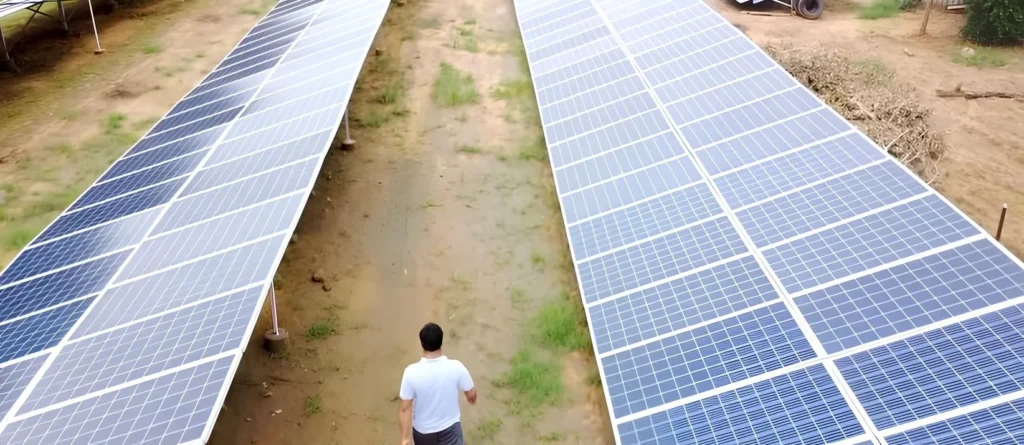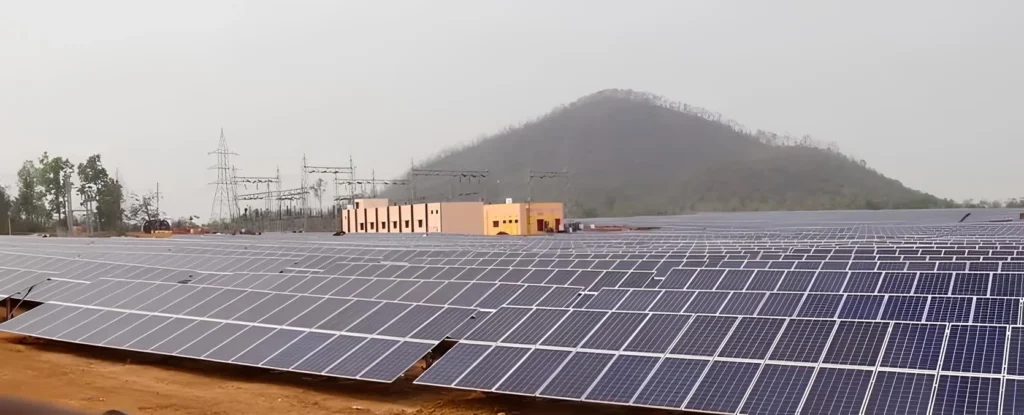1 MW Solar Power Plant Cost and Profit : Step-by-Step Guide
Solar energy is an ever-growing field in India, driven by the country’s need for sustainable energy solutions. By setting up a 1 MW solar power plant, you can contribute to reducing carbon emissions, support the country’s renewable energy goals, and generate a steady stream of income.
Technical Setup of a 1 MW Solar Power Plant Cost and Profit
Step 1: Site Selection and Requirements
- Land Area: Identify and secure around 4-5 acres of land. The land should be flat and free of significant shading from trees or buildings.
- Geographic and Climatic Conditions: Opt for locations with high solar irradiance, minimal cloud cover, and moderate temperatures to maximize efficiency.
Step 2: Components of the Solar Power System | 1 MW Solar Power Plant Cost and Profit
- Solar Panels: Choose high-efficiency photovoltaic panels from reputable manufacturers. You’ll need approximately 3,000-4,000 panels for a 1 MW plant.
- Inverters: Select inverters that match the total capacity of your solar panels. These devices convert the direct current (DC) generated by the panels into alternating current (AC) for grid use.
- Mounting Structures: Install sturdy mounting structures to support the solar panels. They can be fixed tilt or tracking systems to optimize sunlight capture.
- Wiring and Cabling: Use high-quality cables for connecting panels to inverters and inverters to the grid. Proper insulation and weather resistance are critical.
- Monitoring and Control Systems: Implement systems to monitor performance, detect issues, and control operations remotely.
Step 3: Installation Process
- Site Preparation: Clear the land and perform necessary civil works like foundation laying.
- Equipment Procurement: Purchase all components from trusted suppliers, ensuring quality and warranty.
- Installation and Commissioning: Set up the mounting structures, install panels and inverters, connect wiring, and test the system to ensure it’s functioning correctly.
Investment and Costs | 1 MW Solar Power Plant Cost and Profit
Capital Expenditure (CAPEX)
- Cost of Land: Depending on the location, land costs can vary. Rural areas might be cheaper, ranging from INR 15-20 lakhs per acre.
- Equipment and Materials Cost: Budget around INR 3-4 crores for solar panels, inverters, mounting structures, wiring, and other materials.
- Installation and Commissioning Costs: Allocate INR 50 lakhs to 1 crore for labor, transportation, and initial setup.
Operational Expenditure (OPEX) for 1 MW Solar Power Plant Cost and Profit
- Maintenance Costs: Regular maintenance, including cleaning panels and servicing inverters, will cost about INR 5-10 lakhs annually.
- Insurance: Insure your plant against natural disasters and other risks, costing around INR 1-2 lakhs per year.
- Operational Staff: Hiring technical staff for monitoring and maintenance can cost about INR 5-10 lakhs annually.

Earnings and Revenue | 1 MW Solar Power Plant Cost and Profit
Power Generation Potential
- Annual Generation: A 1 MW plant can generate approximately 1.5 million units (kWh) of electricity per year.
Revenue Models
- Power Purchase Agreement (PPA): Enter a long-term agreement with a buyer to sell electricity at a fixed rate, ensuring stable income.
- Sale to the Grid: Sell electricity directly to the state electricity board at the prevailing tariff rate.
- Net Metering: Export excess electricity to the grid and receive credits to offset your own electricity consumption.
Estimation of Annual Income
- Per Unit Selling Price: If you sell electricity at INR 3 per unit, your annual revenue could be INR 45 lakhs.
- Total Units Generated Annually: The calculation is based on generating 1.5 million units per year.
Subsidies and Incentives | 1 MW Solar Power Plant Cost and Profit
Government Subsidies
- Central Government Schemes: Avail schemes like the Central Financial Assistance (CFA) that provide financial support for solar projects.
- State Government Schemes: Each state has its own set of incentives and subsidies. For example, Gujarat and Rajasthan offer attractive benefits.
Tax Benefits
- Accelerated Depreciation: Claim accelerated depreciation on solar equipment, reducing taxable income and improving cash flow.
- Tax Holidays: Certain states offer tax holidays for renewable energy projects, exempting you from state taxes for a specified period.
Other Incentives
- Low-Interest Loans: Obtain loans at reduced interest rates through schemes like the Solar Rooftop Scheme.
- Renewable Energy Certificates (RECs): Earn RECs for the green energy you produce, which can be sold to other entities needing to meet renewable energy obligations.
Financial Analysis | 1 MW Solar Power Plant Cost and Profit
Payback Period
- Calculation: Determine the time needed to recoup your initial investment. If your annual revenue is INR 45 lakhs and total investment is INR 5 crores, the payback period is approximately 10-11 years.
Return on Investment (ROI)
- Estimation: Calculate ROI by dividing annual profits by the total investment. If annual profits (revenue minus OPEX) are INR 30 lakhs, the ROI is around 6%.
Break-even Analysis
- Calculation: Identify the point at which total revenue equals total costs. This helps in understanding the project’s financial viability.
Sensitivity Analysis
- Scenario Testing: Evaluate how changes in key variables like electricity prices, interest rates, and maintenance costs impact overall profitability.

Legal and Regulatory Aspects | 1 MW Solar Power Plant Cost and Profit
Required Approvals and Permits | 1 MW Solar Power Plant Cost and Profit
- Land Acquisition: Secure land-use permissions.
- Construction Permits: Obtain necessary construction permits from local authorities.
- Electricity Board Approvals: Get approvals from the state electricity board for grid connection and net metering.
Compliance with Local Regulations
- Environmental Impact Assessment (EIA): Conduct an EIA to assess and mitigate environmental impacts, if required.
- Safety Standards: Ensure the plant meets all safety and operational standards as per Indian regulations.
Case Studies and Examples | 1 MW Solar Power Plant Cost and Profit
Successful 1 MW Solar Projects
- Examples: Look at projects like the 1 MW solar plant in Neemrana, Rajasthan, or the one in Kolar, Karnataka. These projects provide insights into successful implementation and management.
Lessons Learned and Best Practices | 1 MW Solar Power Plant Cost and Profit
- Key Takeaways: Learn from existing projects about optimal site selection, efficient project management, and effective utilization of government subsidies and incentives.
Conclusion
Setting up a 1 MW solar panel system in India is not only a sustainable and environmentally friendly venture but also a financially rewarding one. With careful planning, securing the right location, understanding the investment costs, and leveraging government incentives, you can ensure a profitable solar energy project. As solar technology continues to advance and government support remains strong, there’s no better time to invest in solar energy and contribute to a greener future.
Ready to harness the power of the sun and make a positive impact? Let’s embark on this solar journey together!
Frequently Asked Questions (FAQs) about 1 MW Solar Power Plant Cost and Profit
Q1: How much land is required for a 1 MW solar power plant? A: You will need approximately 4-5 acres of land to set up a 1 MW solar power plant. The exact amount may vary depending on the type of solar panels used and the layout of the installation.
Q2: What is the total investment required for a 1 MW solar plant? A: The total investment for a 1 MW solar power plant in India ranges between INR 4-5 crores. This includes the cost of land, equipment, installation, and initial setup.
Q3: How much electricity can a 1 MW solar plant generate annually? A: A 1 MW solar plant can generate approximately 1.5 million units (kWh) of electricity annually, depending on the location and amount of sunlight received.
Q4: What are the different revenue models for selling electricity generated by a solar plant? A: The common revenue models include:
- Power Purchase Agreement (PPA): Selling electricity to a third party at a fixed rate.
- Sale to the Grid: Directly selling electricity to the state electricity board.
- Net Metering: Exporting excess electricity to the grid to offset your own electricity consumption.
Q5: What subsidies and incentives are available for solar power projects in India? A: There are several subsidies and incentives available, including:
- Central government schemes like Central Financial Assistance (CFA).
- State government schemes offering additional benefits.
- Tax benefits such as accelerated depreciation and tax holidays.
- Low-interest loans through schemes like the Solar Rooftop Scheme.
- Renewable Energy Certificates (RECs) that can be traded for extra income.
Q6: What is the typical payback period for a 1 MW solar power plant? A: The payback period for a 1 MW solar power plant is typically between 5-7 years, depending on factors like the cost of investment, operational expenses, and revenue generated from electricity sales.
Q7: What kind of maintenance is required for a solar power plant? A: Regular maintenance includes cleaning the solar panels, inspecting and servicing inverters, checking wiring and connections, and ensuring proper functioning of the monitoring and control systems. Annual maintenance costs are generally between INR 5-10 lakhs.
Q8: What approvals and permits are needed to set up a solar power plant? A: You will need to secure various approvals and permits, such as:
- Land use permissions.
- Construction permits from local authorities.
- Approvals from the state electricity board for grid connection and net metering.
- Environmental Impact Assessment (EIA) if required.
Q9: Are there any financial risks involved in setting up a solar power plant? A: Like any investment, there are risks involved. These can include changes in government policies, fluctuations in electricity prices, and unexpected maintenance costs. Conducting a thorough financial analysis and sensitivity analysis can help mitigate these risks.
Q10: How do I choose the right location for my solar power plant? A: Choose a location with high solar irradiance, minimal cloud cover, and moderate temperatures. Areas in states like Rajasthan, Gujarat, and Maharashtra are known for their favorable conditions for solar power generation.
Q11: Can I avail any tax benefits for investing in a solar power plant? A: Yes, there are several tax benefits, including:
- Accelerated depreciation, which allows you to depreciate the value of your solar equipment quickly, reducing taxable income.
- Tax holidays in certain states, exempting you from state taxes for a specified period.
Q12: What are Renewable Energy Certificates (RECs) and how can they benefit me? A: RECs are tradable certificates that represent the environmental benefits of generating electricity from renewable sources. You can earn RECs for the electricity your solar plant generates and sell them to other entities that need to meet renewable energy obligations, providing an additional revenue stream.
These FAQs should help clarify some of the common queries regarding setting up a 1 MW solar power plant in India. If you have any other questions or need further information, feel free to ask!
You Can read this too